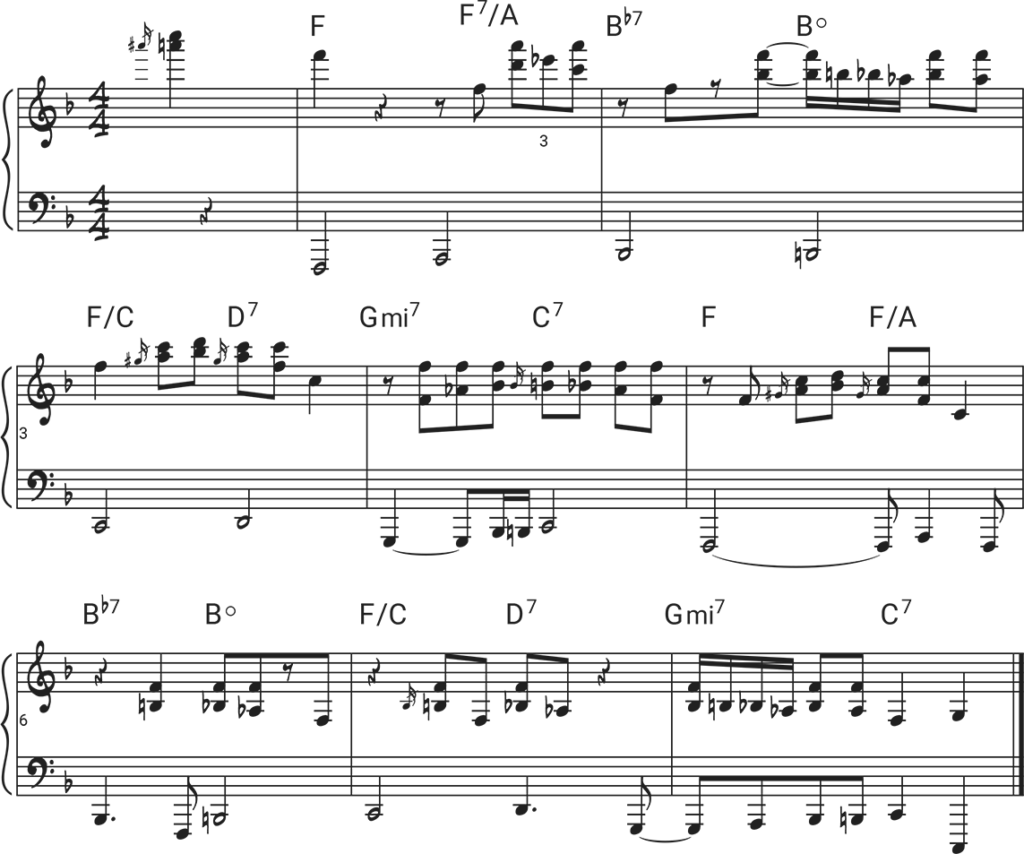Jazz’s gateway drug
One of the earliest jazz records that I remember really liking as a teenager, was Monty Alexander’s “Montreux Alexander”, a live performance album at the Montreux Jazz Festival from 1976. As a 16-year-old, I was certainly not a jazz aficionado yet, still deeply embedded in the indie rock craze of “the” bands of the early 2000s (The Hives, The Thrills, The Strokes, The Libertines, and The Vines, to name a few). But I was slowly acquiring a taste for jazz and blues. “Montreux Alexander” turned out to be a gateway drug for would-be jazz lovers.
My piano teacher, Diederik Idema, the local jazz pianist in my town, would show me jazz albums, gently nudging me towards a total embrace of jazz history. This was one of the albums he introduced me to, and it drew me in immediately. It’s swinging, bluesy, engaging, and energetic, and really proves how much fun jazz and improvisation can be.
However, just calling it a more “accessible” jazz record doesn’t quite do it justice, because it’s so much more than that. In it, you can hear a long line of jazz traditions, including old blues, boogie-woogie, big band (track 3, Duke Ellington’s “Satin Doll,” stands out), call-and-response (“Work Song” has a great bass and piano call-and-response moment), band interaction, the feeling of swing, and even other jazz pianists (Oscar Peterson is a major influence on Alexander).
In this post, I’ll show you how to play a blues piano intro, using Monty Alexander’s version of “Nite Mist Blues” by Ahmad Jamal as an example.
Nite Mist Blues
Recently I played on an old, out-of-tune baby grand and somehow felt the irresistible urge to play the blues, which is an effect old pianos often have on me. Then I remembered “Nite Mist Blues” from this album and decided I had to learn it. Listening to it again after many years brought back the feeling of excitement I felt about discovering jazz as a teenager. It was a great reminder of some of the foundational elements of jazz music that got me into it in the first place; blues, swing, and rhythm.
The blues piano intro
Monty Alexanders’ improvised introduction of “Nite Mist Blues” is a perfect example of how to play a blues piano intro. Much like this whole album introduced me to the genre of jazz, a piano intro should warm the listener up for what’s about to come, give them a taste of the melodies and harmonies, and create anticipation and excitement. A blues piano intro is especially fun because you get to play some of your favorite blues licks, have a playful mindset, and use space and dynamics to set up the tune.
Below, I will break down the 5 key elements of a great blues piano intro as demonstrated by Monty Alexander.
Listen to, and read along with my transcription below:
5 key elements to playing a great blues piano intro
When playing a blues piano intro, you basically have two options:
- play an intro in time, starting in the tempo of the song
- play a rubato piano intro, and start freely, without a tempo yet
In this post, I will focus on the second version, as that’s how Monty Alexander plays his intro to “Nite Mist Blues.” But, I’ll also show a few examples of blues intros that are in time.
1. Blues riffs
In this first step, I’ll be breaking down some common blues riffs and share a few tips on how to come up with them.
Blues Scales — Yes or no?
Oftentimes the blues scale is prescribed to beginning jazz students as a vehicle to improvise over. They might be asked to play the following F minor blues scale:

Just playing this scale up and down rarely results in satisfying melodies. So instead, we often use a combination of the minor blues scale and the major blues scale. The major blues scale goes as follows:

For example, the opening riff of “Nite Mist Blues” uses the major blues scale:

— and the fourth riff uses the minor blues scale —

— but most others are a combination of the two. Here’s the second riff:

It almost doesn’t make sense to think of these riffs in terms of a blues scale. They’re more like short melodies than scales, and the key to playing a good blues intro is to build up a repertoire of these melodies that you can throw in at any moment. Listening and transcribing many blues improvisations is the best thing you can do to bring your blues playing to the next level — more on this later.
Grace notes and blues ornaments
An important aspect of a blues piano intro is using grace notes and ornaments. Think of these as the in-between notes that a traditional blues singer would sing: the bending of the notes and the little riffs and trills that give their phrases so much character.
Grace notes are short notes, usually played half a step below the target note, sliding into it:

Blues ornaments are like grace notes, but they involve more notes and variations. They’re almost like classical trills or mordents, embellishing a simple melody. I think the second half of the opening riff could be considered an ornament of a melodic G resolving to F:

Here are some other bluesy grace notes and ornaments:


Right-hand intervals
Rather than just playing single melodies in the right hand, it often works really well to add an interval on top of the melody you’re playing. This can be a chord tone or just the root:

2. Motivic development
A motif is a short melodic phrase. To create cohesion in your intro, it can be helpful to start with a melodic motif that you can then repeat and develop throughout the intro. For example, Monty Alexander plays an opening motif that then comes back another 4 times, slightly altered each time:

3. Harmonic Structure
Blues riffs and melodic motifs aside, what chords do we play underneath these melodies? It’s often a good idea to have a general sense of the harmonic structure of your intro. Let’s take a quick look at a different blues piano intro and analyze the harmony. This is Oscar Peterson’s introduction to Count Basie’s “Moten Swing,” from the 1959 album “Sonny Stitt Sits in with the Oscar Peterson Trio”:

This harmonic structure is extremely common. It’s a simple ascending bass line from the I-chord to the IV-chord, followed by a turnaround (I – VI – ii – V), played twice:

Going back to “Nite Mist Blues”: Monty Alexander actually starts out with a version of this harmonic structure, but adds in a few additional chords:

A second approach is to use the actual song’s chord changes. For example, we could use the harmonic structure of “Nite Mist Blues,” which looks like this:

It’s a somewhat short and uncommon 8-bar blues form with a bVI7 chord resolving to the V7 chord in measure 6. Now you can use this as a blueprint, and add your own substitutions to it. Monty Alexander uses this basic framework in the second half of his intro, again with some substitutions and additional harmonies:

If you listen to the chords, you’ll note that the way he plays them is very sporadic. They’re often played just briefly, either as an answer to a melodic phrase (like the opening phrase) or as a precursor to them. Think of this as the tradition of call-and-response in jazz.

This brings us to the next element of a great blues piano intro: the usage of dynamics and space.
4. Dynamic and Space
Dynamics
We saw that the chords are often played briefly, but did you notice that they’re also much quieter than the melodies? This contrast in dynamics is important, as it conveys playfulness and captures the listener’s attention quickly. It creates anticipation and makes your flashy blues licks stand out even more!
Melodies should be played dynamically too: exaggerate differences in volume and use accents, crescendos and decrescendos. Monty Alexander is a master of this. If you use contrasting dynamics, it will bring your blues piano intro to life.
Space
As we saw with the harmonies, leaving space in the left hand allows your introduction to breathe. The same goes for the right hand: Alternating quick melodies with sustained notes and space creates a much more interesting and engaging piano intro.
Until the groove comes (at around 0:42 in Nite Mist Blues) you’re also free to stretch the rhythm. The harmonic structure is very loose, so you can hang on the I-chord for a while, or decide to play it only briefly. If your intro is rubato, time is fluid, and you can really experiment with varying rhythms and tempo.
5. Listen
The last and most important step to creating great blues piano intros is: listen! Study the piano greats and transcribe the music you love. It’s a bit of a cliché at this point, but it’s often forgotten or ignored. Everything I’m sharing in this post can be found in great piano intros by Oscar Peterson, Count Basie, Monty Alexander, Ray Charles, Red Garland, and many others. To get you started, I made a selection of great piano intros by some of my favorite pianists. If you know more great examples, please comment below!
Conclusion
There are many ways to play a blues piano intro, but you’ll almost always use blues riffs, develop the melody, play chord changes, use dynamics and space, and apply the things you’ve learned from other pianists. Practice is key here. And try to have fun with it!
Monty Alexander’s live album, and in particular this piano intro, was a great introduction to jazz for me, and I hope it inspired you too! Feel free to comment, share, and follow. For more piano reharmonization tips, download my free Reharmonization Quick Guide here.
Happy practicing!


6 Responses
Greetings from France
Wonderful explanations ! For a long time I have been looking for a transcription of Monty Alexander’s version of nite mist blues but unsuccessfully… you are the first one to propose it, thanks a lot for this fantastic work.
Is there a possibility to buy you the full transcription ? (Or at least a little further than the video on YouTube…).
Thank you again. Alain Croibier
Hey Alain, thanks for your kind words! I loved this version for so many years, so it was fun to finally get that iconic intro under my belt. I didn’t transcribe this one much further but will let you know if I do. It’s definitely a beast to transcribe.
However, if you want other harmonizations / transcriptions delivered straight to your inbox, make sure to sign up for my piano newsletter at pianostringtheory.com/start-here (you’ll get my Reharmonization Quick guide there).
Thanks!
Hello Jorn and Alain
Millon thanks for Nite mist blues intro transcription
same as Crosier Alain, I dream about full transcription book, I am willing to buy it seriously.
Thanks to let me posted
jpclement19441@sfr.fr
Kind regards
Jorn , do you come to france for concerts ?
Hi Jean Pierre, sorry for the late reply! I’m glad your enjoying the Nite Mist Blues post. The Reharm book is almost here, you should receive an email soon!
Jorn
Hi Jorn,
I love your work. Say, can you send me a pdf of how far you got with Monty Alexander’s blues piece. Thank you so much.
Also, do you do transcriptions of short pieces and solos at a reasonable rate? I’m just a hobbyist and have a full-time job. But I’m passionate about music and don’t have time to figure out all of the different solos that I enjoy listening to.
Thanks, Sean
Hey Sean, thanks for the support! At the moment I don’t do for-hire transcriptions, as my different projects take up all of my time and more! I will make sure to do future blog posts of any transcription I’ll do.
I’m seeing you’re on the email list, so I’ll write you personally there!
Jorn